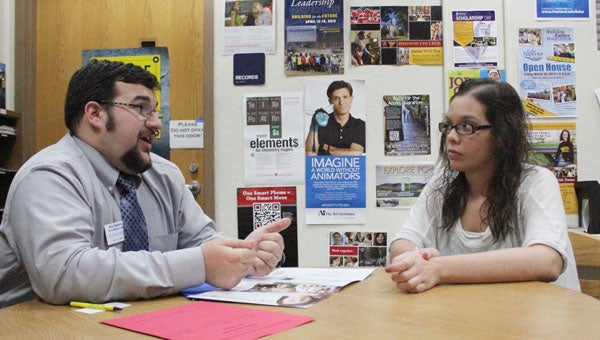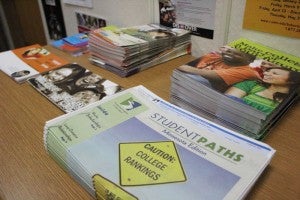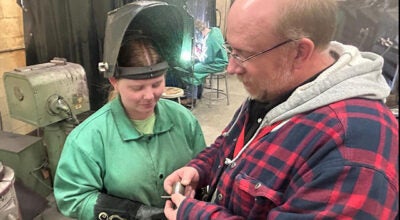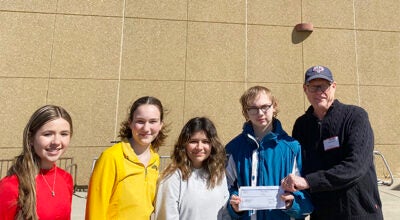Choosing the right path
Published 7:36 am Sunday, April 15, 2012

Alejandra Galvan, a junior, meets with Mike Diamon, a senior admissions counselor for Buena Vista University in Storm Lake, Iowa. The two met recently at Albert Lea High School's career resource center. -- Kelli Lageson/Albert Lea Tribune
Knowing what you want to do after high school isn’t always the easiest decision or biggest priority for middle-schoolers and high-schoolers, so it’s up to staff at the school to motivate children to think about their futures.
A counselor at Albert Lea High School, Kim Danner, said they like to start early when helping children think about their futures. That’s why as early as eighth-grade they host career day and have people come talk to students about all the possibilities open to them.
“Whatever path a student chooses we want them to be the best prepared for it,” Danner said.

Albert Lea High School's career resource center is full of helpful brochures, college applications and financial aid guides.
Danner works closely with Lynn Keenan, another counselor, with all the grades at the high school from eighth- to 12th-grade. She said no matter what a student wants to do after high school, including going to a four-year college or university, a two-year technical school or straight into the workforce or military, they want to help that student be prepared.
Different choices are available
Not every student will head to a four-year school after high school, and Danner said it’s important to cater to all students. Some just don’t have the grades, which makes going to a two-year technical school an option. That way they could get their grades up and possibly transfer to another school.
All eighth-graders get to tour the Riverland Community College campuses in Albert Lea and Austin to see what sort of degrees they could get if they attended. They just had a trip on March 30, where students could choose two different career tracks that interested them including law enforcement, liberal arts, wind turbine technicians and more.
“They get to see what the campus is like,” Danner said. “A panel of students talk to them about course choices and how their GPA matters.”
For students who are unsure of what they’d like to do, Danner said the high school is uniquely able to give them a taste of many different things. Elective choices range from robotics to welding to art and more.
Then there are the students who would rather enter the workforce or military as soon as they get their diploma, and Danner said there’s ways to prepare them for that as well.
“Even if someone just wants to work after school we can teach them the importance of attendance and taking ownership and being responsible for yourself,” Danner said.
Four-year degrees still a goal for many
Though the school stresses that there are lots of options for students, many still want to work toward a four-year degree after high school. Albert Lea High School’s Career Resource Center has more than enough tools to help these students.
One student, Alejandra Galvan, a junior at ALHS, recently met with an admissions counselor from Buena Vista University, which is in Storm Lake, Iowa. She was interested in their science programs because she’d like to be a doctor, and so she signed up on the day a representative would be in Albert Lea.
“It was really nice, instead of going to the school, he just came here,” Galvan said.
She also said she’s been helped greatly by the staff at the high school in terms of picking the right elective choices for her goals. For her those include zoology, forensic science and physics.
The CRC is packed with brochures, college applications, financial aid help and more. Representatives come straight to the school to talk about how college visits work and what students need to get accepted.
There’s also the annual college fair to help seniors finalize their choices. More than 100 colleges and universities are represented, along with military options.
“Kids can gather information and talk to college reps,” Danner said. “It’s a very unique opportunity to have that many colleges for students and families to talk to.”
The road to a four-year degree
Most likely the biggest test to judge a student’s academic ability is the ACT. Juniors who are looking to continue their education must take it, as all colleges look at the ACT score and GPA when looking at applications.
“Most state universities look for a student in the top 50 percent of their class with at least a 21 on the ACT,” Danner said.
Sophomores can take the ACT Plan test, which can help them identify their weaknesses.
“The higher your ACT score the better off you’ll be, but the majority of all colleges are looking at all parts of the student,” Danner said.
They do take into consideration the level of difficulty of classes, so someone with a GPA of 3.2 who took college-level classes would fare better than others with higher GPAs who had taken less-intensive classes. No matter what level of classes students take, Danner said all students are prepared for some sort of college, whether it’s two- or four-year.
“Our curriculum is college prep,” Danner said. “You are prepared in our course curriculum to go to college.”
Another important step parents and students have to take is looking into financial aid to see which schools they’d be able to afford. And yet another important step is finding the right classes to prepare you for your eventual career, or first figuring out what career you’d like to pursue.
Danner said the school has many valuable resources to help students learn about occupations and what sort of work it takes to get to that point. The school uses the MCIS, or Minnesota Career Information System, which is virtual trove of information. The site is available to all ALHS students, and the link can be found on the district’s website.
Students can research colleges and universities by price, location or programs they offer. They can find financial aid and scholarships through the site and learn about creating resumes. There’s also a personality test that shows students careers they might find interesting, and then the student can look at that career’s pay scale, need and education requirements.
“If you have a desire to go to college there’s a way to get there,” Danner said.
Making students aware of options
From eighth-grade on, students are presented with options and opportunities to help them learn more about what they’d like to do after high school. From career day to college visits, they’re able to explore the world outside high school, if they want.
Danner said sometimes it can be hard to advertise all the resources available to students. One effective way students learn about what’s at the CRC and about testing is through advisory. Advisers talk to their students about meeting with counselors and other resources that are available.
“I tell parents to stay involved,” Danner said.
Parents can look at grades and even grades of specific assignments through the student management system, Genesis. There’s also all-school assemblies where students can learn more about the opportunities available to them.
Danner said the most important thing they hope students know is that the staff are there to help them through the process of finding what exactly it is they’d like to do after high school.




